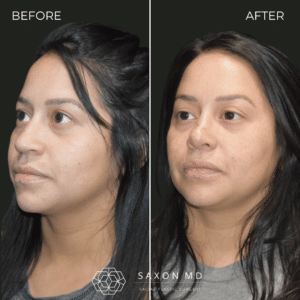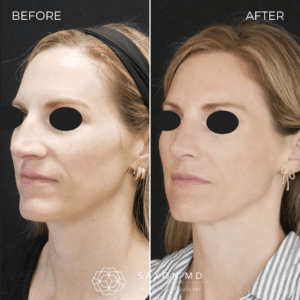Nose Job Recovery Time: What to Expect After Rhinoplasty
So, you’ve decided to get a rhinoplasty (commonly known as a nose job), and now you’re wondering what the recovery process is like. Knowing what to expect can help ease some of the anxiety around your surgery and ensure you’re prepared for a smooth recovery. This guide will walk you through what happens day by day in the first two weeks after your procedure, as well as what to expect over the next year. From dealing with pain and swelling to knowing when you can get back to your normal routine, let’s dive into everything related to nose job recovery time.

First Two Weeks: Day-by-Day Breakdown
Day 1: Surgery Day
The day of your surgery, you’ll be groggy from anesthesia, and a drip pad may be placed under the nose to help manage any bleeding. It is common to have mild oozing in the first 24 hours. A splint or cast will be placed on the outside of your nose to protect it and maintain the new shape. You won’t feel much pain at this point due to the lingering effects of anesthesia, but discomfort is normal. You might feel congested and have difficulty breathing through your nose because of the swelling. Expect some bruising and swelling around your nose and eyes.
Pain Level: Mild to moderate, easily managed with prescribed pain medication.
Activity: Strict bed rest; avoid any movement that may strain your nose.
Day 2-3: Initial Discomfort Peaks
Around day two or three, the swelling and bruising around your nose and eyes will likely peak. You might experience pressure in your nasal passages and sinus areas, making breathing through your nose difficult. Rinsing your nose out with Neilmed Sinus Rinse can help with breathing after any dried mucous or blood is cleaned out.
This is also when pain or discomfort may be at its highest, but pain medications will help manage it. Don’t worry—this discomfort usually subsides after day three. Alternating Tylenol and Ibuprofen during these first few days helps significantly with pain control.
Pain Level: Moderate, controlled with pain medication.
Activity: Rest, light walking around the house is encouraged to improve circulation, but no strenuous activities.
Day 4-5: Swelling and Bruising Begin to Subside
By the fourth or fifth day, the worst of the bruising and swelling should begin to subside. You’ll likely start feeling more comfortable, though your nose will still be very swollen, and it might still be hard to breathe through it. You may have some residual bleeding, but it will be much less than in the first few days.
Pain Level: Mild to moderate, often reduced by day five.
Activity: Light walking is fine, but avoid bending over, lifting anything heavy, or engaging in any activity that might raise your blood pressure.
Day 6-7: Splint Removal
Between day six and day seven, Dr. Saxon will remove your splint. This is a big milestone in your recovery, and you’ll get your first look at your new nose! Be prepared, though: it will still be very swollen, and your final results won’t be visible for quite some time. After the splint is removed, you might feel like your nose is stuffy or tight, but you’ll be able to breathe more easily compared to the first few days.
Pain Level: Minimal, though your nose will still feel tender.
Activity: You can start gently washing your face again, avoiding any pressure on the nose area.

The patient above had a rhinoplasty 1 week prior to the photo. Her cast was just removed. You can see slight bruising under the eyes as well as mild swelling on the nasal bridge and tip. Bruising can easily be covered with concealer at this point.
Day 8-10: Visible Improvement
By now, the swelling and bruising will have gone down significantly, though your nose will still be swollen. You’ll start feeling much more like yourself, and everyday activities will become easier. Most of the significant discomfort should be gone, though your nose will remain tender, and you may still have some difficulty breathing. At this point, you’ll start seeing more of the early results of your surgery, though the final shape of your nose won’t settle in for several months.
Pain Level: Minimal.
Activity: You can resume light daily activities, but still avoid anything strenuous.
Day 11-14: Getting Back to Normal
By the end of the second week, most patients feel ready to return to work or school, as long as their job doesn’t require strenuous physical activity. The majority of the bruising and visible swelling will have gone down, and you’ll likely feel much more comfortable, though your nose will still be swollen. You may still experience some tightness or numbness around the nose.
Pain Level: Almost none.
Activity: Resume light activities, but hold off on exercise, bending over, or lifting heavy objects for at least another week or two.
Nose Job Recovery Time in the First Year
While most of the dramatic swelling and discomfort subsides within the first two weeks, the full rhinoplasty recovery process can take up to a year. Here’s what to expect in the months following your surgery.
One Month Post-Surgery
After about four weeks, most of the noticeable swelling will have subsided, and you’ll feel much more comfortable. At this point, most patients feel ready to resume regular exercise, though it’s best to avoid contact sports or any activity where your nose could be hit. Breathing will become easier as internal swelling decreases, and you’ll start to see more of the final shape of your nose.
Pain Level: None.
Activity: Normal daily activities and exercise can be resumed, but avoid anything that could impact the nose directly.
Three Months Post-Surgery
By the three-month mark, around 90% of the swelling will be gone, and you’ll have a good idea of what your final results will look like. Your breathing should be fully back to normal, and any lingering bruising will be long gone. You might still experience some minor swelling, especially in the tip of your nose, but this will gradually subside.
Pain Level: None.
Activity: Resume all regular activities, including contact sports with your surgeon’s approval.
Six Months Post-Surgery
At six months, most patients won’t notice any remaining swelling, though Dr. Saxon will still be monitoring your progress to ensure everything is healing properly. The tip of the nose may still feel slightly stiff, but this will continue to soften over time. Your breathing should be completely normal by this point, and you’ll likely have forgotten all about the early discomfort of recovery.
One Year Post-Surgery
By the one-year mark, your nose should be fully healed, and you’ll be able to see the final results of your surgery. Any residual swelling in the tip will have resolved, and the shape and size of your nose will have settled. At this point, your nose should feel completely natural, and your breathing will be as clear as ever.

Common Questions About Nose Job Recovery Time
How Much Pain Should I Expect After a Nose Job?
Pain after rhinoplasty is typically mild to moderate and can be managed with prescription pain medications in the first few days. Most patients report that discomfort, congestion, and pressure in the nasal area are more bothersome than actual pain. By the end of the first week, most of this discomfort will be gone.
When Can I Return to Work?
Many patients feel ready to return to work after about 10 days, but this depends on the nature of your job. If your work involves strenuous physical activity, you may need to take more time off to ensure proper healing.
How Long Will My Nose Be Swollen?
Most of the swelling will subside within the first month, but some minor swelling, particularly around the tip of the nose, can linger for several months. It can take up to a year for all swelling to fully resolve and for your final results to be visible.
When Can I Exercise Again?
You should avoid strenuous exercise for at least three to four weeks following surgery. Light activities, such as walking, can be resumed sooner, but anything that raises your blood pressure or involves the risk of impact to the face should be avoided for several weeks.
Conclusion
Recovering from a nose job takes time, patience, and a little bit of self-care, but the results are well worth it. While the first two weeks can be challenging, most patients feel comfortable and ready to return to normal life after that point. Full recovery takes up to a year, but by staying patient and following your surgeon’s guidelines, you’ll be well on your way to enjoying your new look.